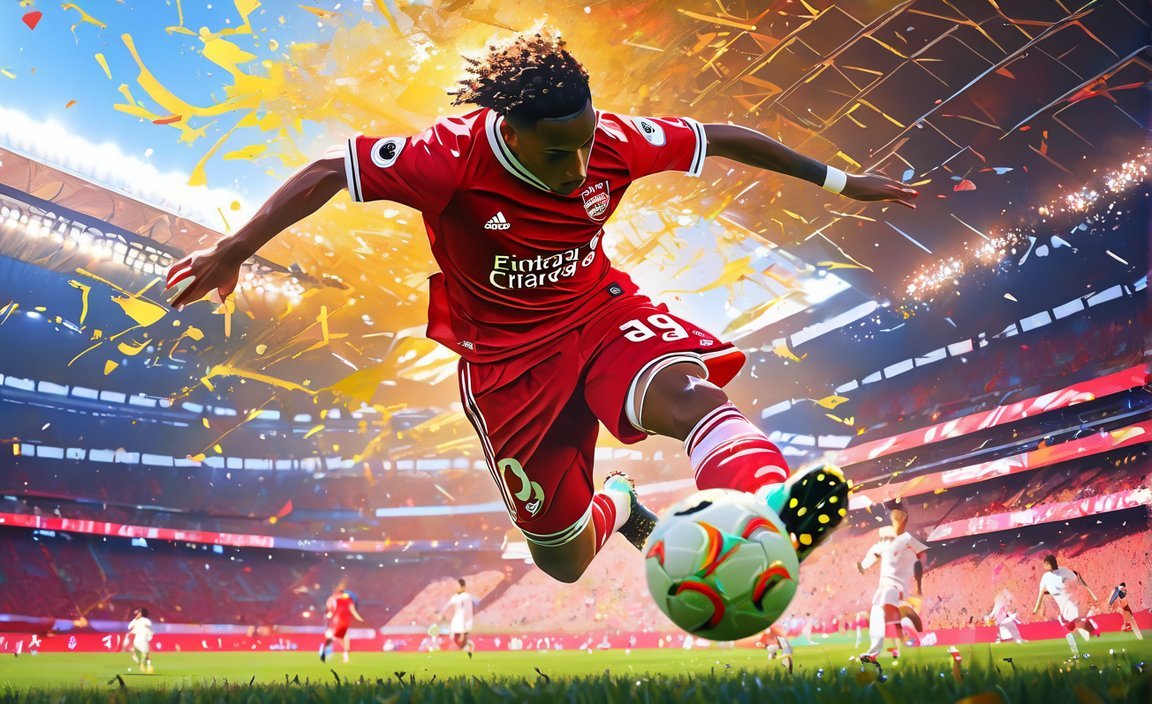Experience the electrifying world of football as we delve deep into the tactical intricacies and thrilling match moments that make this sport the heart and soul of millions. In this article, titled “Tackling Football: Unveiling Tactical Intricacies and Thrilling Match Moments,” we will uncover the secrets behind the mesmerizing strategies, player performances, and breathtaking highlights that leave fans in awe. So grab a seat, get ready to be captivated, and let us take you on an unforgettable journey through the exhilarating realm of football.

Key Takeaways:
- A tackle in soccer is a defensive action where a player attempts to gain possession of the ball from their opponent through one-on-one encounters.
- There are two main methods of tackling in soccer: extending the foot to grab the ball or sliding towards the opponent to take the ball away.
- Tackling in soccer has evolved to focus more on winning possession rather than dominating confrontational situations.
- Effective communication and skillful approaches to tackling can enhance a team’s ability to win possession.
- Good defenders in soccer possess the ability to read the play, anticipate attackers’ movements, and understand their opponents’ preferred space.
- Developing physical literacy, including footwork and movement skills, is crucial for defenders in modern soccer.
- In Australian rules football, a tackle involves wrapping, holding, or wrestling a player with possession of the ball to the ground, similar to rugby.
- Different types of tackles exist in Australian rules football, such as the perfect tackle that prevents an opponent from disposing of the ball.
- Proper tackling techniques in football include accelerating to the ball, shooting from the breakdown position, and resorting to a shoulder-to-shoulder challenge as a last resort.
- Tackling techniques in soccer include the poke tackle, block tackle, shoulder-to-shoulder challenge, and slide tackle.
- Maintaining proper form, including keeping the feet shoulder-width apart, is important in tackling in football.
Tackling Football: Unveiling Tactical Intricacies and Thrilling Match Moments
Football, a sport defined by its dramatic moments and strategic battles, wouldn’t be complete without the art of tackling. As the defender’s weapon of choice, tackling plays a crucial role in winning back possession and stopping the opposition’s attacks. In this instructional guide, we will dive deep into the world of tackling football, exploring the techniques, strategies, and thrilling match moments that make it such an essential aspect of the game.
The Evolution of Tackling in Soccer
Tackling in soccer has undergone a significant transformation over the years. In the early days, it was often a confrontational act, with players using sheer force to overpower their opponents. However, as the sport has evolved, tackling has become more technical, emphasizing the art of winning back possession rather than dominating through physicality. The focus now lies in timing, precision, and tactical decision-making.
Mastering the Techniques: Tackling Methods and Approaches
To be an effective tackler in soccer, it is crucial to understand and execute the various techniques at your disposal. Let’s delve into some key tackling methods and approaches that players can employ on the field.
The Poke Tackle:
The poke tackle involves extending your foot to intercept the ball from an opponent. It requires excellent timing and coordination, as mistiming your move can lead to fouls or missed opportunities. By swiftly extending your leg, you can disrupt the opponent’s control and regain possession.
The Block Tackle:
In the block tackle, the defender positions themselves to block the opponent’s path, forcing them to alter their direction or lose control of the ball. This technique focuses on positioning and anticipation, aiming to impede the attacker’s progress while maintaining a legal and clean approach.
The Shoulder-to-Shoulder Challenge:
As a last resort, the shoulder-to-shoulder challenge allows defenders to physically engage with opponents. This method involves using your shoulder to make contact with an opponent’s shoulder, disrupting their balance and potentially winning back possession. It is crucial to approach this technique with caution to avoid committing a foul.
The Slide Tackle:
The slide tackle is a high-risk, high-reward tackling technique. It involves launching oneself to the ground and sliding towards the opponent, attempting to take the ball away. Proper execution requires impeccable timing and a meticulous understanding of the game situation to avoid dangerous fouls or injuries.
Reading the Play: Anticipation and Spatial Awareness
Truly exceptional defenders in soccer possess the ability to read the play, anticipate their opponents’ movements, and understand the space they aim to exploit. By analyzing the dynamics of the game, observing the positioning of attackers, and studying their tendencies, defenders can increase their chances of successfully executing tackles. Developing a strong sense of spatial awareness and honing the ability to predict your opponent’s next move will elevate your tackling prowess.
Promoting Skillful Approaches and Effective Communication
In the modern game of football, there is a greater emphasis on skillful approaches to tackling, focusing on precision and technique rather than aggression alone. Coaches and team leaders play a vital role in promoting these skillful approaches and fostering open communication within the team. By encouraging players to express themselves, make calculated decisions, and work together as a unit, teams can enhance their tackling efficiency and overall defensive performance.
Physical Literacy: Footwork and Movement Skills
A key aspect of becoming a successful defender in today’s soccer is the development of physical literacy. This encompasses footwork, agility, and movement skills that are crucial for tackling effectively. By refining your footwork techniques, practicing quick changes in direction, and improving your overall agility, you can enhance your ability to make timely tackles and disrupt the opposition’s attacks.
Conclusion
Tackling football is not merely about overpowering opponents but rather a strategic dance of anticipation, technique, and spatial awareness. The evolution of tackling in soccer has seen it transform into a more refined art form, with players seeking to win back possession through skillful and precise techniques. By mastering the various tackling methods, honing spatial awareness, promoting skillful approaches, and developing physical literacy, players can elevate their tackling prowess and contribute significantly to their team’s defensive success.
So, embrace the intricacies of tackling football and embark on a journey filled with tactical brilliance and heart-stopping moments. Unleash your inner defender and let the art of tackling shape the course of the game.
- Basketball Rules: Are you new to basketball or need a refresher on the rules? Click here to learn about the essential basketball rules that you should know before hitting the court.
- Flag Route Football: Want to add some excitement to your football playbook? Discover the secret behind the thrilling flag route and level up your offensive strategy. Click here for all the details.
- Defense for Lacrosse: Looking to improve your defensive skills in lacrosse? Uncover the top defensive strategies and techniques that will help you dominate the game. Check them out by clicking here.
- Basketball Referee Hand Signals Numbers: Have you ever wondered what those hand signals mean during a basketball game? Learn the secret language of basketball referees by knowing the hand signals and numbers. Click here to become an expert!
- Blocking Foul Motion Ref: Are you confused about the complexities of blocking fouls in basketball? Dive into the intricacies of this crucial call and gain a better understanding of the role of the motion ref. Click here to gain valuable insights.
- Goalie Boxes in Soccer: Curious about the goalie boxes in soccer? Discover the significance of these marked areas on the field and how they affect gameplay. Click here to learn all about goalie boxes.
- Pitching in the Stretch: Are you a pitcher looking to improve your performance on the mound? Master the art of pitching in the stretch and gain an edge over your opponents. Click here to uncover the secrets of a successful stretch pitch.
- Kevin Durant Zodiac Sign: Did you know that Kevin Durant has a unique zodiac sign? Find out what his sign says about his gameplay and personality. Click here to explore the intriguing world of basketball players and astrology.
Proper Techniques for Executing a Successful Tackle
Football is a game full of exciting moments, and one of the most crucial aspects is the tackle. The proper execution of a tackle can make all the difference in a game, both in terms of winning back possession and preventing the opposing team from advancing. In this article, we will delve into the essential techniques for executing a successful tackle, equipping you with the knowledge to become a formidable defender. So, let’s dive in!
Approaching the Ball Carrier with Control
To set the foundation for a successful tackle, it’s important to approach the ball carrier with control. As you near the opponent, chop your feet and get under control. This allows you to maintain balance and be ready to execute the tackle when the time is right[^1^].
Aiming for the Inside Hip of the Ball Carrier
Once you have established control, your target for the tackle should be the inside hip of the ball carrier. Aim to make contact with this specific area, as it provides a more effective and secure tackle[^2^].
Engaging the Ball Carrier with Proper Technique
Engaging the ball carrier with the right technique is crucial to executing a successful tackle. Use your shoulder pads to make contact, keeping your head up and ensuring that it is across the body of the ball carrier. By doing so, you maintain a strong and secure position, reducing the risk of injury and increasing your chances of a successful tackle[^3^].
Tackling Through the Ball Carrier
One common mistake in tackling is stopping the feet upon contact. To avoid this, it’s important to tackle through the ball carrier. Maintain your momentum and drive through, using your legs and body to bring them down. The extra force applied through tackling the ball carrier will lead to a more secure tackle[^4^].
Finishing the Tackle by Grabbing Cloth
To ensure a complete and successful tackle, finish strong by grabbing hold of the ball carrier’s cloth. Maintaining a strong grip makes it difficult for the opponent to escape and increases the effectiveness of your tackle. So, don’t forget to use this final technique![^5^].
Key Takeaways:
- Approaching the ball carrier with control is crucial for a successful tackle.
- The target for a tackle should be the inside hip of the ball carrier.
- Engage the ball carrier with proper technique by using your shoulder pads and keeping your head up.
- Tackle through the ball carrier by maintaining momentum and driving through with your legs and body.
- Finish the tackle by grabbing hold of the ball carrier’s cloth to increase its effectiveness.
Remember, mastering the proper techniques for executing a successful tackle takes practice and discipline. By incorporating these techniques into your game, you’ll become a more effective defender and play a pivotal role in your team’s success.
Sources:
[^1^]: Coach’s Tribune – Football Hitting: How to Tackle
[^2^]: Coach’s Tribune – Football Hitting: How to Tackle
[^3^]: Youth Football Online – How to Tackle with Proper Tackling
[^4^]: Youth Football Online – How to Tackle with Proper Tackling
[^5^]: Coach’s Tribune – Football Hitting: How to Tackle
Key factors to consider when deciding to tackle
In the game of football, tackling is a crucial defensive skill that can turn the tide of a match. However, deciding when to tackle requires careful consideration and strategic thinking. Here are key factors to consider when deciding to tackle in football:
Timing is everything
Tackling at the right moment is essential to avoid giving away unnecessary fouls or missing the opportunity to regain possession. Timing your tackle is about understanding the rhythm of the game, reading the movements of the ball carrier, and anticipating the perfect moment to initiate a tackle. By observing the position of the ball and the movements of the opponent, you can assess when to make your move effectively.
Assessing the situation
Not all situations call for a tackle. Sometimes it’s wiser to hold back and let your teammates handle the defensive duties. Evaluating whether a tackle is necessary involves weighing the risks and rewards. Is the opponent in a dangerous scoring position? Will a tackle disrupt their attacking play? Considering the context of the game and the position of your teammates can help you make an informed decision.
Choose the right technique
There are various tackling techniques in football, and selecting the appropriate one depends on the circumstances. Considering the type of tackle that best fits the situation is crucial for success. Whether it’s a block tackle, a slide tackle, a poke tackle, or a shoulder tackle, each technique has its own advantages and risks. Understanding the strengths and limitations of each technique will enable you to apply the most suitable one in different scenarios.
Positioning and body control
Before attempting a tackle, it’s important to position yourself correctly and maintain control over your body. Reading the position of the ball carrier and the anticipated trajectory of the ball will help you find the right position to initiate a tackle. Additionally, focusing on your body balance, footwork, and agility will aid in executing a successful tackle. Remember to keep your head up, engage the opponent with your shoulder pads, and drive through with your legs and body.
Team coordination
Football is a team sport, and successful tackling requires coordination with your teammates. Pay attention to the positioning of your teammates on the field to ensure cohesive defensive efforts. By communicating and coordinating with your fellow players, you can effectively mark opponents, cover open spaces, and support each other in tackling situations. Understanding your defensive roles and responsibilities will contribute to a more organized and effective defensive strategy.
Safety first
While football is a physical game, player safety should always be a priority. Avoid tackling with both feet off the ground as it is considered illegal and dangerous play. Tackling from behind should also be avoided to prevent injuries and comply with the rules. Maintaining a fair and safe approach to tackling not only protects the players but also promotes a positive and sportsmanlike culture within the game.
Sources:
- Soccer Coaching Pro: How to Tackle in Soccer (4 Techniques All Players Must Know) [^1^]
- Wikipedia: Tackle (football move) [^2^]
Key Takeaways:
- Timing your tackle is crucial for success.
- Evaluate the situation before deciding to tackle.
- Choose the appropriate tackling technique for the situation.
- Positioning and body control are important for a successful tackle.
- Coordinate with your teammates for a more effective defensive strategy.
- Prioritize player safety in tackling.
Tips for Improving Tackling Skills
Tackling is an essential skill in football that can greatly impact the outcome of a game. Whether you’re a defender or a midfielder, honing your tackling abilities can help you regain possession of the ball and halt the opposing team’s progress. In this article, we’ll explore some valuable tips to enhance your tackling skills on the field. Let’s dive in!
Timing Is Key
One crucial aspect of effective tackling is timing. By studying your opponent’s movements and patterns, you can anticipate when they’ll make their next move. This anticipation allows you to time your tackle carefully, aiming to intercept the ball just as your opponent touches it. According to Soccer Coach Theory, timing is everything when it comes to tackling[^1].
Anticipation Is Crucial
Read the game and anticipate where the ball will go next. Position yourself strategically, ready to pounce on the ball as soon as the opportunity arises. This requires a good understanding of the game and the ability to predict the next play. Better Soccer Coaching suggests that a well-executed tackle requires anticipation and being in the right position at the right time[^1].
Practice Proper Technique
Understanding and using the correct tackling technique is essential for success and safety. Start by keeping your feet shoulder-width apart, shoulders back, and getting low with a roughly 45-degree angle. Additionally, constantly “buzz” or shuffle your feet to maintain mobility and readiness to react[^2]. According to Gridiron Elite Training, maintaining balance and a low center of gravity is crucial for effective tackling in football[^1].
Build Core Strength
Developing a strong core can enhance your tackling power and stability. Exercises such as planks, sit-ups, and Russian twists can help improve your core strength. A strong core will not only improve your tackling ability but also reduce the risk of injuries[^1].
Practice Tackling Drills
Regularly incorporating tackling drills into your training sessions can help improve your technique and decision-making skills. These drills simulate real-game scenarios and provide opportunities to refine your tackling abilities. Football Advantage suggests practicing drills that focus on correct tackling form and reinforce the best ways to tackle[^3].
Key Takeaways:
- Timing is crucial in tackling and involves studying your opponent’s movements and patterns.
- Anticipation plays a significant role in successful tackling by reading the game and positioning yourself strategically.
- Practicing proper technique is essential for effective and safe tackling, including maintaining balance, a low center of gravity, and using footwork.
- Building core strength through exercises like planks and twists enhances tackling power and stability.
- Regularly practicing tackling drills helps improve technique and decision-making skills.
Sources:
[^1]: How to Tackle in Soccer – Soccer Coach Theory
[^2]: How to Tackle in Football: 14 Steps (with Pictures) – wikiHow
[^3]: 5 Football Tackling Drills to Be More Effective on Defense – Football Advantage

FAQ
Q1: What is the importance of timing in tackling in soccer?
A1: Timing is crucial in tackling in soccer because it allows the player to intercept the ball just as the opponent touches it, increasing the chances of a successful tackle. By studying the opponent’s movements and patterns, players can anticipate when they will make their next move and time their tackle accordingly.
Q2: How can anticipation improve tackling abilities in soccer?
A2: Anticipation is crucial in soccer tackling as it allows players to read the game and predict where the ball will go next. By positioning themselves strategically and being ready to pounce on the ball, players can increase their chances of successfully tackling the opponent. Anticipation requires a good understanding of the game and the ability to predict the next play.
Q3: What are some key elements of proper tackling technique in football?
A3: Proper tackling technique in football involves keeping the feet shoulder-width apart, the shoulders back, and getting low with a roughly 45-degree angle. It is important to maintain balance and a low center of gravity. Additionally, constantly “buzzing” or shuffling the feet helps to maintain mobility and readiness to react. Grabbing hold of the ball carrier’s cloth and maintaining a strong grip is also crucial for a successful tackle.
Q4: How can core strength improve tackling abilities in soccer?
A4: Core strength plays a significant role in enhancing tackling power and stability in soccer. Exercises such as planks, sit-ups, and Russian twists can help improve core strength. A strong core not only improves tackling ability but also reduces the risk of injuries, allowing players to maintain stability and power during tackles.
Q5: Why is practicing tackling drills important for improving tackling abilities?
A5: Regularly practicing tackling drills is essential for improving tackling abilities in soccer. Tackling drills simulate real-game scenarios and provide players with opportunities to refine their technique and decision-making skills. These drills focus on correct tackling form and reinforce the best ways to tackle, allowing players to enhance their skills and contribute to their team’s success.
- Georgia Platform: A Southern Strategy, 1850s - March 31, 2025
- How many weeks is 40 days: Quick Conversion Guide for Accurate Results - March 31, 2025
- How many feet is 300 meters? 984 Feet: Understand Length Conversions Easily - March 31, 2025
















